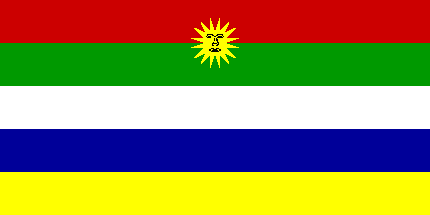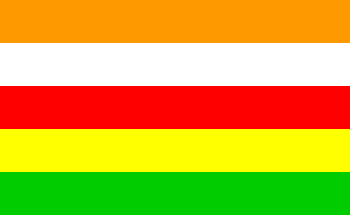|
|
|
|
|
Such is the incredible repression unleashed against the Rajputs in Brahmin-Controlled India that the Rajputs are even forbidden from flying their ancestral flags. This act is considered a civil offence. Thus, the Flags of the World website notes that -
" ... the princely flags are banned. State flags for the modern Indian states do not exist save for Jammu and Kashmir. ... The "ex-princely" families still use the flags, although the central government doesn't like it ... Most of the residences of the ex-rulers still fly the State flag, for example Gwalior or Jaipur, those rulers who still own their "houses" in New Delhi ... None of this is legal, as such."
In this context it is to be noted that the Indian flag does not even represent the Rajputs as there is no yellow color symbolising the Sun. It is the duty of every Rajput to continue the usage of his ancestral flags and to proudly continue the Rajput tradition. As part of this effort, the RLFS here provides some of the historical Rajput flags, flags for which the ancient Rajput would gladly give his life.
The original flag of Jaipur in 1877 contains a Sun to represent the Saura-Saka religion of the Rajputs and a yellow band to further emphasise that heritage. It is is depicted below -

Later, the flag was slightly altered. It is here -

The Flags of the World website writes regarding this flag -
"Jaipur - also Jeypore. Former Indian state, East Rajputana, NW India, now in Rajasthan state; 15.610 square miles, capital: Jaipur. Founded in 12th century (probably 1128) by Rajput chief from Gwalior; furnished famous generals to Mogul emperors; came under British protection 1818; title: maharaja."
The state of Idar was annexed to the Brahmin-Occupied-Government on June 26, 1947 and usage of the ancestral Rajput flag strictly forbidden. Liks the flag of Jaipur, it contains a yellow band to symbolise the Sun and its high status with the Rajputs. This historical flag is shown below -

The flag of Banswarra has a bright yellow margin, symbolising the Sun, surrounding a red center, symbolising fire. Once again, the ancestral Saura-Saka descent of the Rajputs is emphasised in this magnificent flag.

The Bikaner flag has a red upper stripe over a lower orange-saffron stripe, symbolising the supremacy of Sun-worship over Brahmanism (Vedism and Vaishnavism).

Regarding Bikaner, the Flags of the World website states
" Bikaner was a former Indian state, now part of Rajasthan, NW India; 23,181 square miles; desolate tract, part of Thar Desert without a single stream. The northern part is watered by irrigation channels. Founded about 1465 by Rajput chief; adhered loyally to Mogul Empire; waged wars with Jodhpur through 18th century; received British political agent in 1883. Capital, Bikaner, is 140 miles West of Delhi."
The Independant Rajputana state of Kishengarh was annexed to the Brahmin-Occupied Government on Jun 26, 1947. Its historical flag is given below -

The Marwari flag contains a red and yellow stripe symbolising fire and the Sun, respectively. This symbolises the Saura religion of the Rajputs. It is as follows -

Marwar is described as "region borders on Thar Desert on W, touches Great Rann of Kutch on SW; traversed by Luni river flowing SW"
The Tonk flag is as follows -

The flag of Bharatpur in Mewat consists of a bright yellow center and two thin horizontal light blue bands. The center symbolises the Sun and the central role it plays in the life of the Rajput. It is as follows -

Long live Rajputana !
Pratap Gehlote